Speaking of funding infrastructure
If you work in planning, you see lots of community plans, with great ideas and vision.
Most communities have limited funding sources, mostly local property and sales taxes, supplemented by fees for permits and licenses, and maybe personal property taxes too--because local jurisdictions have limited revenue sources for the most part is the reasoning behind personal property taxes, although you could argue that annual taxing of automobiles provides funds that support maintenance of the road network, plus access to government funds from the county, state, and federal levels. (DC as a city is unique in the U.S., as it enjoys the revenue stream from 100% of local [equivalent to state] income taxes.)
There has been talk of a National Infrastructure Bank to help fund rehabilitation of roads, bridges, and other often decaying infrastructure. But the intent is for big projects that are regional in scope, justifying federal involvement.
I was reading a plan for Petersburg, Virginia, produced by the Regional Urban Design Assistance Team program of the American Institute of Architects, and it occurred to me that we need another kind of National Infrastructure Bank, one focused on assisting local jurisdictions in jumpstarting their revitalization.

PWA worksite, Washington, DC, 1933. FDR Library photo.
Just one of the more than one dozen projects in the Petersburg plan was projected to cost between $12 to $15 million.
How about the equivalent of a new fund (a la the Works Progress Administration and the Public Works Administration projects constructed for localities during the Depression) to support community revitalization projects at the town-city-county level? And transit too.
Virginia does have a model, the Governor's Fund, but I imagine the demand far exceeds the money available. (Just like with transit projects and the availability of federal government funding.)
Governor’s Fund—A statewide grant offered to communities, the Governor’s Fund can be used for a variety of uses including on-site utility improvements, site acquisition and development, and the construction or build-out of publicly-owned buildings. In order to receive the grant, the development must create a specified number of jobs as well as attain a certain amount of private assistance, a figure that is based upon population specifics. Funding amounts are determined by the governor of Virginia. The grant requires an application process submitted by the chief appointed official for the jurisdiction. (From the R/UDAT report.)

Vehicles are scattered along the broken remains of the Interstate 35W bridge, which stretches between Minneapolis and St. Paul, after it collapsed into the Mississippi River during evening rush hour Wednesday, Aug. 1, 2007, sending vehicles, tons of concrete and twisted metal crashing into the water. (AP Photo/The Minnesota Daily, Stacy Bengs)
But why should we wait for absolute destruction before funding revitalization activities?
(Another idea I had, although I didn't get the project, at least that one, as part of revitalization activity for Takoma Park, Maryland (and the DC portion) would be to construct a streetcar line from Walter Reed on Georgia Avenue to Takoma Metro and from there to the New Hampshire Avenue-University Boulevard intersection in Langley Park, where there will be a Purple Line light rail station, to provide additional links to the subway system and the light rail system, and to connect the various Takoma commercial districts with a higher level of transit service. But the reality is, where would they get the funding to do something like this?)
Labels: economic development, infrastructure, national economic competitiveness, public finance



0 Comments:
Post a Comment
<< Home